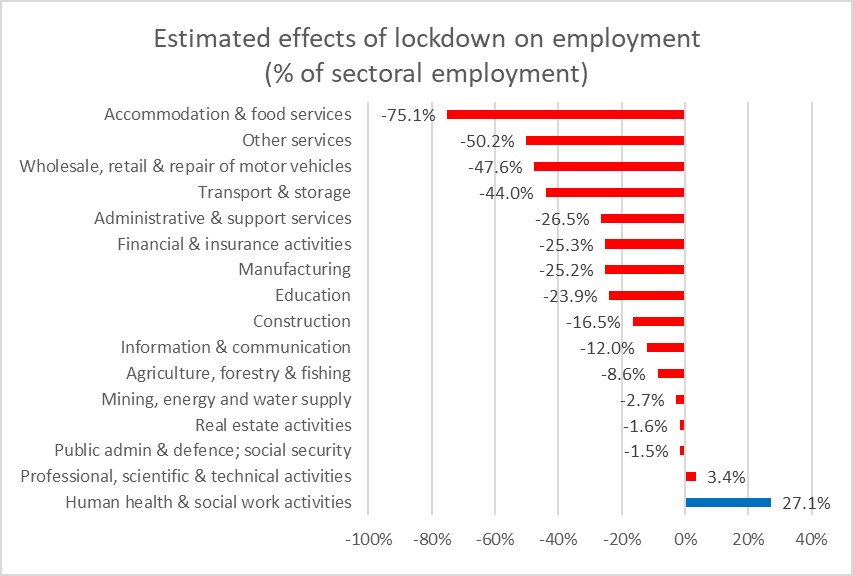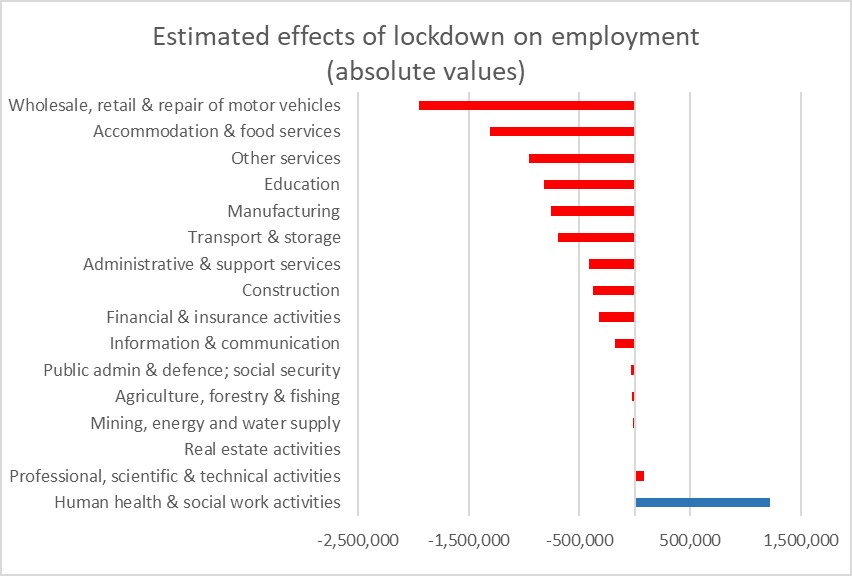Using the most updated Input-Output tables provided by the ONS (2016), we have quantified the overall effects on the UK economy of different lockdown scenarios. In more detail, following a similar reasoning to Keogh-Brown et al. (2010) and Dorn et al. (2020), we have assumed the lockdown implies some reduction in the final demand of goods and services (this includes demand from households and government, as well as investments and exports), plus constraints on the supply side, for instance due to reduced productivity of working from home. We have then worked out how this reduction is passed on to the intermediate demand – the productive engine of the country.
Our baseline scenario predicts an overall contraction in GDP and employment of around 20%, including direct and indirect effects.
As Figure 1 shows, the most badly affected sector is Accommodation & Food Services (-75%), followed by Services and retail (almost halved), and transport (-44%). To be noted, some of the assumptions about the reduction in final demand in these sector are more drastic, but intermediate demand required by other sectors partly offsets this change. Agriculture, Forestry & Fishing loses one job in 10, mainly due to reduced demand by the Accommodation & Food Services sector. Mining, Energy and Water Supply, Real Estate Activities (mostly composed of rents), together with Public Administration and Techical Activities are barely affected, while the Health sector sees a significant increase in overall production and employment (+27%).
Figure 2 reports the scenario assumptions and the estimated effects on production and employment, by sector of activity.
Our next step will be to evaluate the impact of the macroeconomic consequences of the lockdown on household disposable income, inequality and poverty, and quantify the cost of the rescue package put forward by the Government.
Figure 1: Estimated effects of lockdown on employment, by industry (%).

Figure 2: Estimated effects of lockdown on employment, by industry (absolute numbers).

References
-
Florian Dorn, Clemens Fuest, Marcell Göttert, Carla Krolage, Stefan Lautenbacher, Sebastian Link, Andreas Peichl, Magnus Reif, Stefan Sauer, Marc Stöckli, Klaus Wohlrabe, Timo Wollmershäuser (2020). The Economic Costs of the Coronavirus Shutdown for Germany: A Scenario Calculation. EconPol Policy Brief 3(21).
-
Marcus R. Keogh-Brown, Simon Wren-Lewis, W. John Edmunds, Philippe Beutels, and Richard D. Smith (2010). The Possible Macroeconomic Impact on the UK of an Influenza Pandemic. Health Economics 19: 1345–1360.
